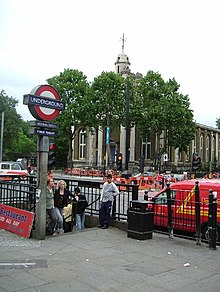Bethnal Green tube station
It lies between Liverpool Street and Mile End stations, is in Travelcard Zone 2, and is open 24 hours on a Friday and Saturday as part of the Night Tube service.On 3 March 1943, 173 people, including 62 children, were killed in a crush while attempting to enter the shelter, in what is believed to be the largest loss of civilian life in the UK during the Second World War.The 1935–40 London Passenger Transport Board (LPTB) New Works Programme included a new deep level station in Bethnal Green as part of the Central line extension from Liverpool Street to Ongar and Woodford over the London & North Eastern Railway suburban branch to Epping and Ongar in Essex, as well as a new underground line between Leytonstone and Newbury Park mostly under the Eastern Avenue to serve the new suburbs under-development in the north Ilford and the Hainault Loop.Home Secretary of the day Herbert Morrison disagreed, and Clement Attlee, MP for the nearby Limehouse constituency, wanted to prevent rumours that the panic was due to "Jews and/or Fascists".[12][13] At the end of the war, the Minister of Home Security, Herbert Morrison, quoted from a secret report to the effect that there had been a panic, caused by the discharge of Z Battery anti-aircraft rockets fired from nearby Victoria Park.The secret official report, by a Metropolitan magistrate, Laurence Rivers Dunne, acknowledged that Bethnal Green Council had warned London Civil Defence, in 1941 that the staircase needed a crush barrier to slow down the crowds but was told that would be a waste of money.[30] In 1975, the ITV network broadcast a dramatised television film about the disaster, It's A Lovely Day Tomorrow, directed and produced by John Goldschmidt, and with a script by Bernard Kops, who as a 16-year-old had witnessed the event.On 1 April 2016, Dr Joan Martin, who was on duty as a junior casualty officer at the nearby Queen Elizabeth Hospital for Children and led the medical team dealing with the dead and wounded from the incident, told BBC Radio 4's Eddie Mair about her personal experiences on the evening of the disaster, and its long-term effects on her life.The station entrances, all in the form of subway access staircases to the subterranean ticket hall, show the design influences of Charles Holden, the consulting architect for London Transport at this time.


Bethnal Green railway stationBethnal GreenLondon Borough of Tower HamletsLondon UndergroundTransport for LondonLondon Passenger Transport BoardCoordinatesCentral lineLiverpool StreetMile EndTravelcard Zone 2Night Tubeair-raid shelterSecond World WarNew Works ProgrammeLondon & North Eastern RailwayEppingLeytonstoneNewbury ParkEastern AvenueIlfordHainault LoopMetropolitan Borough of Bethnal GreenCivil Defence ServiceGermanySoviet UnionRoyal Air Forceair-raidCivil Defence sirenasphyxiatedAir Raid WardenDaily MailWinston ChurchillHome SecretaryHerbert MorrisonClement AttleeLimehouse constituencyVictoria ParkMr Justice SingletonMaster of the RollsLord GreeneLaurence Rivers Dunnecrush barrierNorth ShieldsStratford stationMetronetCommonwealth War Graves CommissionMetropolitan Borough of StepneyITV networkdramatised television filmJohn GoldschmidtBernard KopsInternational EmmyThe Naked Civil ServantWhitechapel GallerySir John SoaneSt John on Bethnal GreenQueen Elizabeth Hospital for ChildrenBBC Radio 4Eddie MairLondon TransportPoole PotteryHarold StablerCharles HoldenEaling BroadwayWest RuislipNortholtWhite CityHainault via Newbury ParkWoodford via HainaultLoughtonHainaultWoodfordLondon BusesShoreditch High Street railway stationLondon OvergroundEast London lineElizabeth lineCrossrailChesshyre, D. H. B.Wayback MachineBBC NewsThe GuardianThe StageBBC News OnlineWar & SocietyCharity Commission for England and WalesTheydon BoisDebdenBuckhurst HillSouth WoodfordSnaresbrookRoding ValleyChigwellGrange HillFairlopBarkingsideGants HillRedbridgeWansteadLeytonStratfordSt Paul'sChancery LaneHolbornTottenham Court RoadOxford CircusBond StreetMarble ArchLancaster GateQueenswayNotting Hill GateHolland ParkShepherd's BushEast ActonNorth ActonWest ActonHanger LanePerivaleGreenfordSouth RuislipRuislip Gardens1992 StockBlake HallBritish MuseumNorth Weald